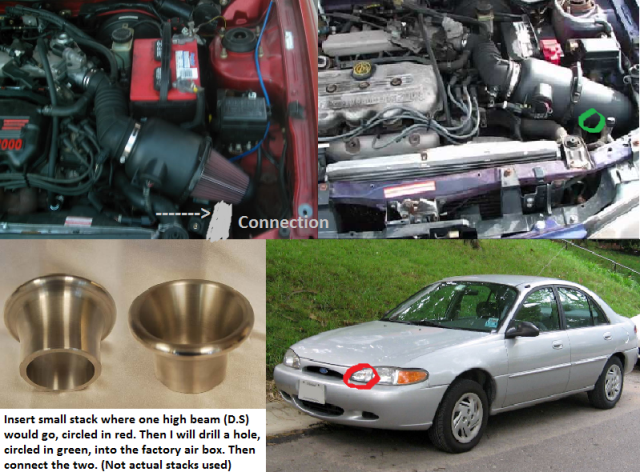Velocity stack incorporated into headlight?
So I'm rebuilding a 1997 Ford Escort (SOHC) for a daily driver. I'm doing a build series of before and after the rebuild. I will do compression numbers, a few 40-70 pulls, and the range I get on a tank. I'm NOT trying to make this car into a "tuner/sports" car. I'm simply rebuilding it for my daily driver since the parts are cheap and it gets 34mpg and only weights 2400lbs!
Anyways I have it all figured out but there's one segment in my build I'm wondering if I should do for poops and giggles. I was thinking about drilling around a 1 inch in diameter, or however big the high beam is to make room for a velocity stack that will feed directly into the factory air box. I'm going to replace the filter obviously but if I can pull this job off cleanly, it should add a little fuel economy and lower intake temps. I plan on it being a brushed silver or paint it the same green as my escort.
Thoughts on this? Do you think it would be a waste of time? If all goes wrong replacement head lights for this car is like 35 dollars. It is mainly for the build series and to be a bit unique, I don't want it to look trashy though, but if done right it might just blend in a bit. Plus this car is already pretty peppy because of how light it is. I'm getting new refurbished fuel injectors, new fuel pump, and fuel filter (just to name the fuel system). Maybe a small increase in cooler airflow will help it on long heatstroke drives.
Won't do much. Just suck more junk/water into the airbox/filter. Factory box gets cool air already. Plus, engine comp already is compensating for intake temp. Couple hours of rainy driving after a dry spell (more junk on the road) and your air filter will be shot.
It won't work. Here's why: The PCM in that car uses the O2 sensor to monitor fueling. If you get more air in it, the computer HAS to add more fuel (lean=bad, google it). The ONLY benefit to cold air is the density, and it's about 1HP for every 10* drop… So in other words, not much. Free, but so is stock.
So wha tyou have vs. Stock, the ONLY difference is if you are able to eliminate work that the engine has to do to suck air through the intake tract. It's very unlikely you will make enough difference to even measure in that regard, the OEM's aren't stupid.
Along the lines of testing, I'd Really have someone else drive it before/after, and have them drive the exact same route/speed/etc using cruise control. There are way too many variables you can't control (weather being one huge one) so measuring even 1-2MPG difference is not really scientifically valid.
Your MAF sensor does most of the work regarding fuel. You do not need o2 sensors to run a car. They just help with emissions and fine tuning of air/fuel ratios. If there are no sensors the car runs rich to protect it, not lean. I know this because my 3000gt has none since I have installed these cruddy headers, this spring it will turbo swapped and the stock vr4 manifolds have o2 slots so I can run them again. It just makes my car use more fuel and not as powerful.
While yes the yields would be small, they would be present and it is a fun project too. Also about your points about all of those variables. I feel when I rebuild this ford from 1997 the fuel economy will increase measurably. Mainly because the tranny shifts hard that is getting a shift kit, possible rebuild, torque converter, old spark plugs and wires, old injectors and pump and fuel filter, batter, alternator, old air filter, plus I'm adding a new refreshed head and gaskets along with some other things so it will run more efficiently. Exact to the point numbers, no, but if I drive three tanks before and three after the break in then yes It should increase. If it was 20-30 miles per tank that would be great!
- Replacing headlight bulbs 07 Ford Taurus SE? I have a 07 Taurus SE and wanted to know what's the best/brightest of all headlight bulbs I can use without buying a conversion kit that won't cause me to blind people in front of me
- I have a 2000 ford Taurus station and can't put it into gear.why can't I put it into gear? I have a 2000 ford Taurus station and can't put it into gear. Why can't I put it into gear?
- 2002 ford taurus headlight are dim? The high and low beams are way to dim I can ride with the hight beam on and still to low and it does, nt bother anybody
- 1997 Ford Ranger 4.0 V6 won't shift into drive after being driven. Takes longer than should to shift into drive when first started? It will go in reverse fine. First thing in the morning when I leave for work, it will shift into drive on it's own, but takes a bit longer than it should. After getting it warm, won't shift into drive at all. I can shift down to 1st or 2nd, then back into drive and it will "pop up" into drive within a second or 2. I also have a ODB2 error P1744 (Torque Converter circuit).